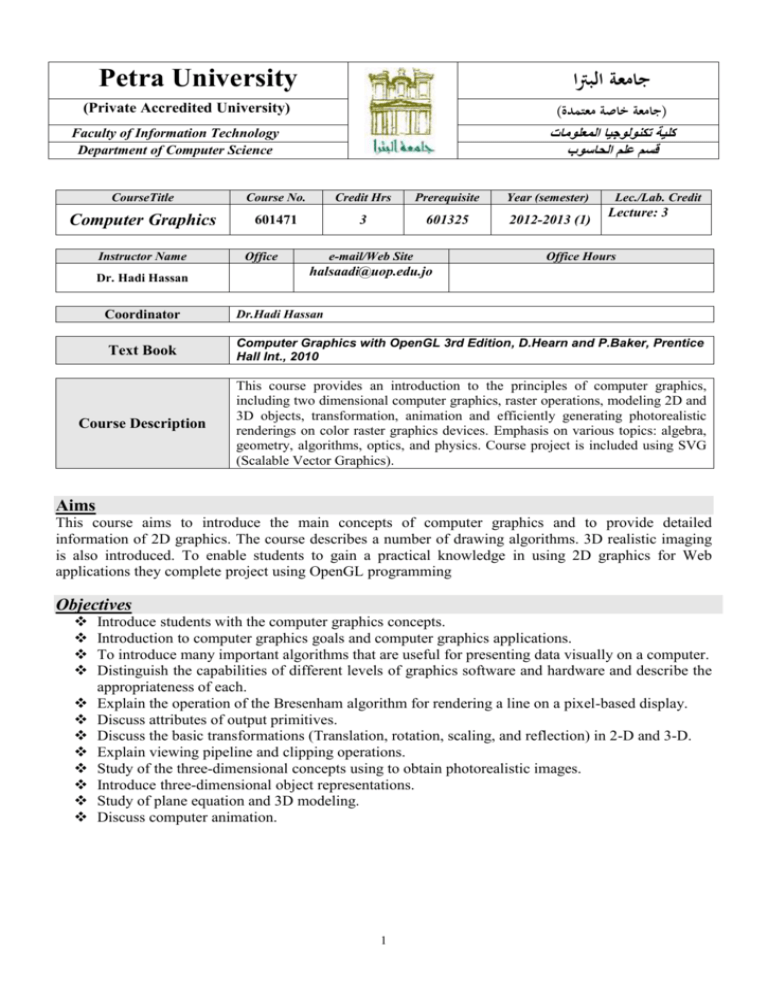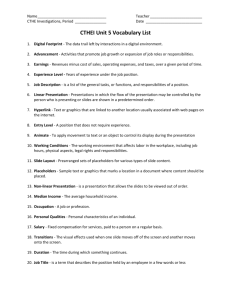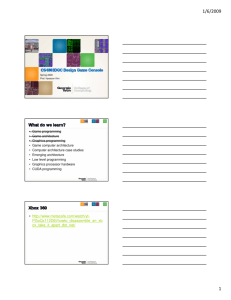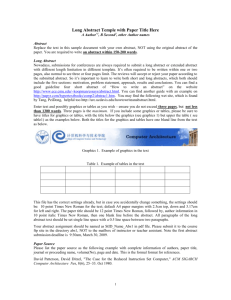
جامعة البرتا
Petra University
)(جامعة خاصة معتمدة
(Private Accredited University)
كلية تكنولوجيا المعلومات
قسم علم الحاسوب
Faculty of Information Technology
Department of Computer Science
CourseTitle
Computer Graphics
Instructor Name
Dr. Hadi Hassan
Course No.
Credit Hrs
601471
3
Office
Prerequisite
601325
e-mail/Web Site
Year (semester)
2012-2013 (1)
Lec./Lab. Credit
Lecture: 3
Office Hours
halsaadi@uop.edu.jo
Coordinator
Dr.Hadi Hassan
Text Book
Computer Graphics with OpenGL 3rd Edition, D.Hearn and P.Baker, Prentice
Hall Int., 2010
Course Description
This course provides an introduction to the principles of computer graphics,
including two dimensional computer graphics, raster operations, modeling 2D and
3D objects, transformation, animation and efficiently generating photorealistic
renderings on color raster graphics devices. Emphasis on various topics: algebra,
geometry, algorithms, optics, and physics. Course project is included using SVG
(Scalable Vector Graphics).
Aims
This course aims to introduce the main concepts of computer graphics and to provide detailed
information of 2D graphics. The course describes a number of drawing algorithms. 3D realistic imaging
is also introduced. To enable students to gain a practical knowledge in using 2D graphics for Web
applications they complete project using OpenGL programming
Objectives
Introduce students with the computer graphics concepts.
Introduction to computer graphics goals and computer graphics applications.
To introduce many important algorithms that are useful for presenting data visually on a computer.
Distinguish the capabilities of different levels of graphics software and hardware and describe the
appropriateness of each.
Explain the operation of the Bresenham algorithm for rendering a line on a pixel-based display.
Discuss attributes of output primitives.
Discuss the basic transformations (Translation, rotation, scaling, and reflection) in 2-D and 3-D.
Explain viewing pipeline and clipping operations.
Study of the three-dimensional concepts using to obtain photorealistic images.
Introduce three-dimensional object representations.
Study of plane equation and 3D modeling.
Discuss computer animation.
1
Intended Learning Outcomes and their alignment with Program ILOs :
Successful completion of this course should lead to the following learning outcomes :
A- Knowledge and Understanding:
1) Understand computer graphics software and hardware used in graphical systems.
2) Understand output primitives (lines, conics, filled polygons).
3) Understand principles, concepts, and algorithms of Computer Graphics.
B- Intellectual Skills:
1) Recognize coordinate representation and graphics functions of general graphics packages.
2) Compare between alternative 3D objects representations.
3) Analyze computer graphics algorithms.
C) Practical skills/Subject Specific Skills:
1) Code developing in OpenGL .
2) Understanding relation of algebra and geometry to computation algorithms used in Computer Graphics.
D) Transferable Skills relevant to employability and personal development:
1) Discuss various concepts of nowadays photorealistic graphics (e.g., 3D mesh, projection, illumination and
viewing).
2) Preliminary knowledge in VRML as an example of 3D geometry and connectivity.
3) Ability independently to gather, filter, and organize source code material from various sources (including
library, electronic and online resources), and to be able to develop Open GL code.
4) Capacity to create graphical design, using appropriate output primitives, attributes and animation.
Teaching and Learning Methods:
Interactive lectures (IlOs: A1, A2, A3, B1, B3, C1, C2, D1, D2)
Lecture on major concepts and issues: Interactive lectures with PowerPoint slides and graphics demonstrations (2D
using OpenGl viewer and 3D using VRML Cortona viewer) are conducted with lecturer explaining and illustrating
the concepts. Students will be invited to share their view and experience in applying the concepts.
Projects (ILOs:A1, A2, B1, C1, D3, D4)
Students will work on a course projects individually. Each student will create a graphical design that will be a
sketch for SVG course project. The feasibility of design then will be discussed. At the end of the semester student
will submit the project. To complete submission students will be asked to add some changes to the design to prove
the ability to develop OpenGL code.
Online search (ILOs: B1, C1, D3)
Each student will be required to search the net for information about SVG. A Quiz that contains questions related,
for example, to definition, advantages and applications of SVG tests students’ search work.
Textbook Problems (ILOs: A1, A2, A3)
Problems have been selected for in-class illustration of certain concepts and applications.
Outside-classroom activities (ILOs: A3, B2, C2, D1, D2)
Students are required to recall computer graphics applications, such as CAD packages, painting programs and
latest animated movies. Students are invited to watch the animated movies again but with purpose to recognize
concepts and principles of computer graphics that they study during this course.
Companion Web Site (ILOs: C1, D3)
o
OpenGl Tutorial http://www.cs.uccs.edu/~semwal/indexGLTutorial.html
2
Course Contents :
Week
1
Topics
A Survey of
Computer
Graphics
Topic Details
Applications of Computer Graphics, Rendering,
Modeling, Animation.
Ref.
CH1
2
Overview Of
Graphics Systems
CH2
3,4
Output
Primitives
Video Display devices.
Color CRT monitors, Flat-Panel Displays, LCD
LED, Input devices, Graphics software
Points.
Line Drawing Algorithm.
Parallel Line Algorithms
Circle Generating Algorithms, Properties of Circles.
Mid-Point Circle Algorithms.
Pixel Addressing and Object Geometry.
Filled-Area Primitives, Scan Line Polygon Fill
Algorithm.
Inside-Outside Test Boundary-Fill Algorithm, Flood Fill
Algorithm.
Color and Gray Scale Level, Color Table, Gray Scale.
Inside-Outside Test Boundary-Fill Algorithm, Flood Fill
Algorithm.
Translation, Rotation, scaling
5
Attribute Of
Output
Primitives
6, 7
Two-Dimensional
Geometric
Transformations
8,9
Two-Dimensional
Viewing
10
11-12
Two-Dimensional
Geometric
Transformations
13-14
Three
Dimensional
Concepts
3D viewing
14
ThreeDimensional
Geometric And
Modeling
Transformations
15
Computer
Animation
16
First Exam
Reflection, Shear.
Viewing coordinate reference frame, Window-to-view
port coordinate transformation
Clipping operations, Point clipping, Cohen-Sutherland
line clipping.Liang Barsky Clipping algorithm
Polygon clipping.
Open GL overview lecture ( Progarmming language)
Project Initial Proposal
Structures and hierarchical modeling
CH3
Assignment
HW1
HW2
CH4
CH5
HW3
CH6
HW4
CH7
Translation , Scaling ,rotation , Reflection and shearing
Three-dimensional display and view methods, Parallel
projection, perspective projection
Second Exam
Project / Acceptance
Hidden Suface Detection
CH9
HW5
CH11
HW6
CH16
Final Exam
CONTINUAL COURSE Quality IMPROVEMENT
The following Measures are taken seriously to continuously improve the quality of the course:
3
Student Feed back: Using the University Student Evaluation, and the IT faculty Special Evaluation
Form to provide instructor and department with feedback.
Peer Visitation: Feedback from faculty members with similar specialization
Course Coordinator: Participates in course updates, and monitors course progress
Internal Examiner: Feedback pertaining to course outline, exams and projects, Course objectives and
ILOs
External Examiner: Feedback pertaining to course outline, exams and projects, Course objectives and
ILOs
ACM, AIS, and AITP Curriculum Guidelines
MOH Guidelines for Standard Efficiency Exams
Assesment and Grade Distribution
Assesment
Individual Work
Project
Quiz and HW
ILOs
Requiremet for Grading / Due Date
A1, A2, A3, B1, B2, B3, C1, C2, D1, D2, D3, D4
Proposal + SVG program
First Exam
Second Exam
A Comprehensive
Final examination
Points
10%
10%
Covers Chapters 1 – 4
Multiple Choice Questions worth 25% of
exam Grade. Three to Four Essay Questions
worth 75% of exam grade.
Covers Chapters 5 – 10
Three to Four Essay Questions worth 100%
of exam grade.
Covers Chapters 1 – 16.
Multiple Choice Questions worth 15% of
exam grade. Essay Questions worth 85% of
exam grade.
TOTAL
Total
100%
20%
20%
20%
40%
40%
40 %
100%
References:
[R1] Computer Graphics C version
Second Edition, Donald Hearn and M. Pauline Baker,
Prentice Hall Int., 1997
[R2] Baker / Hearn, “Computer Graphics with OpenGL”, 3rd edition 2003.
[R3] F.S.Hill,JR/ Stephen M.Kelley , ”, 3rd edition 2002 pearson , Prentice Hall
[R4]
Lecture's Notes
COURSE POLICIES
The University Regulations on academic dishonesty will be strictly enforced! Please check the University Statement
on plagiarism.
Make-up Exams: Only students with valid excuses are allwed to have make up exams. All excuses must be signed by
the Faculty Dean. Student has the responsibility to arrange with his/her instructor for an exam date before the
occurrence of the next regular exam.
All assignment and class work must be submitted at the specified due date. No late work will be accepted.
Attendance policy will be stricktly enforeced (refer to student's Handbook).
No make up for quizzes under any circumstance.
4
Last updated by Dr. Hadi Hassan , Feb.7. 2013
Approved by:
Course Coordinator
Curreculum Committee
Quality Assurance Committee
Faculty Dean
Name
Date
5
Signature









